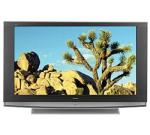
Available sizes: 42"-70"
Advantages:
Ultra sharp image - Due to the large pixel gap, these displays can look extremely sharp at the right distance.
No rainbow effect - Unlike DLP, there is no possibility for a rainbow effect.
Advantages:
Black level - While LCD is getting better black levels with each passing model year, the other microdisplay technologies are usually a little bit better.
Screen door effect - Due to the large pixel gap, sitting too close to one can make it look like you're watching TV through a screen door.
First, we'll clear one thing up. The difference between LCD and DLP isn't huge, so if someone tells you one is clearly better than another, they're going by what they read and not what they've seen. Both are so close, most novices would have a hard time telling them apart.
Most manufacturers have picked one or the other to produce, but there are a few (like LG) that make both. TV makers like LCD since the parts can be manufactured in-house, or sourced from various manufactuerers at a lower price. DLP must be purchased from Texas Instruments.
LCD technology has been around for a very long time. So for those of you who are careful of adopting new technologies, you should feel safe and sound with good ol' LCD.
One of the clear advantages to LCD RPTVs is the lack of a rainbow effect. Since these TVs use a separate LCD chip to process each primary color, the rainbow effect common in single chip DLP TVs is avoided.
Another characteristic of LCD that serves to both help and hurt LCD is the larger gap between each pixel. At the right distance, the gap can make LCD TVs look extremely sharp, but won't provide a film-like experience. However, sitting too close can make it like looking through a screen door, so be careful not to match a screen size too big for your viewing distance.
Return to Understanding the Different Types of TVs




